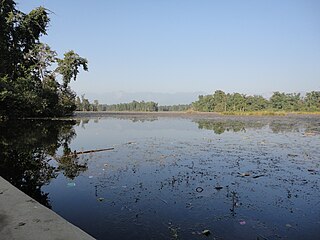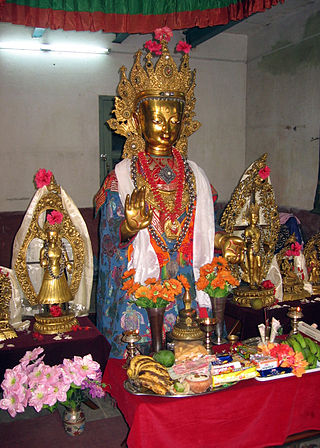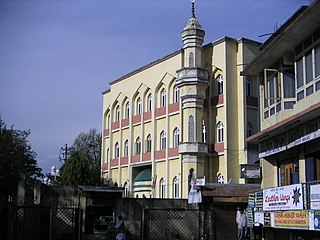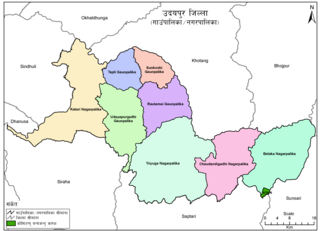Related Research Articles

Newar or Newari, known officially in Nepal as Nepal Bhasa, is a Sino-Tibetan language spoken by the Newar people, the indigenous inhabitants of Nepal Mandala, which consists of the Kathmandu Valley and surrounding regions in Nepal.

Newar or Nepami, are the historical inhabitants of the Kathmandu Valley and its surrounding areas in Nepal and the creators of its historic heritage and civilisation. Newars form a linguistic and cultural community of primarily Indo-Aryan and Tibeto-Burman ethnicities following Hinduism and Buddhism with Nepal Bhasa as their common language. Newars have developed a division of labour and a sophisticated urban civilisation not seen elsewhere in the Himalayan foothills. Newars have continued their age-old traditions and practices and pride themselves as the true custodians of the religion, culture and civilisation of Nepal. Newars are known for their contributions to culture, art and literature, trade, agriculture and cuisine. Today, they consistently rank as the most economically and socially advanced community in Nepal, according to the annual Human Development Index published by UNDP. Newars are ranked the 8th largest ethnic group in Nepal according to the 2021 Nepal census numbering 1,341,363 people constituting 4.6% of the total population.
Buddhism in Nepal started spreading since the reign of Ashoka through Indian and Tibetan missionaries. The Kiratas were the first people in Nepal who embraced Gautama Buddha’s teachings, followed by the Licchavis and Newar people. Buddha was born in Lumbini in the Shakya Kingdom. Lumbini lies in present-day Rupandehi District, Lumbini zone of Nepal. Buddhism is the second-largest religion in Nepal. According to 2001 census, 10.74% of Nepal's population practiced Buddhism, consisting mainly of Tibeto-Burman-speaking ethnicities and the Newar. However, in the 2011 census, Buddhists made up just 9% of the country's population.

Kailali District, a part of Sudurpashchim Province in Terai plain, is one of the 77 districts of Nepal. The district, with Dhangadhi as its district headquarters, covers an area of 3,235 square kilometres (1,249 sq mi) and has a population 911,155 and, .

Religion in Nepal encompasses a wide diversity of groups and beliefs. Nepal is a secular nation and secularism in Nepal under the Interim constitution is defined as "Religious and cultural freedom along with the protection of religion and culture handed down from time immemorial." That is, "The state government is bound for protecting and fostering Hindu religion while maintaining "Religious" and "Cultural" freedom throughout the nation as fundamental rights.
The Nepalese caste system was the traditional system of social stratification of Nepal. The Nepalese caste system broadly borrows the classical Hindu Chaturvarnashram model, consisting of four broad social classes or varna: Brahmin, Kshatriya, Vaishya, Sudra.

Newar Buddhism is the form of Vajrayana Buddhism practiced by the Newar people of the Kathmandu Valley, Nepal. It has developed unique socio-religious elements, which include a non-monastic Buddhist society based on the Newar caste system and patrilineality. The ritual priestly (guruju) caste, vajracharya and shakya form the non-celibate religious clergy caste while other Buddhist Newar castes like the Urāy act as patrons. Uray also patronise Tibetan Vajrayana, Theravadin, and even Japanese clerics. It is the oldest known sect of the Vajrayana tradition outdating the Tibetan school of Vajrayana by more than 600 years.

Islam is the third largest religion in Nepal. According to the 2021 Nepal census, approximately 1.483 million Muslims, comprising 5.09% of the population, live in Nepal.
Madheshi people is a term used for several ethnic groups living in the central and eastern Terai region of Nepal. It has also been used as a political pejorative term by the Pahari people of Nepal to refer to non-pahari people with a non-Nepali language as their mother tongue, regardless of their place of birth or residence. The term Madheshi became a widely recognised name for Nepali citizens with an Indian cultural background only after 1990. Madheshi people comprise various cultural groups such as Hindu caste groups, Muslims, Marwaris, Brahmin and Dalit caste groups, ethnic groups like Maithils, Bhojpuri, Awadhi and Bajjika speaking people and indigenous people of the Terai. Many of these groups share cultural traditions, educational and family ties with people living south of the international border in Bihar, Uttar Pradesh and West Bengal. Tharu people and Pahari people living in the Terai do not consider themselves as Madheshi. In recent times, some politicians and journalists use the term for all Nepali citizens of the Terai.
Triveni is a rural municipality in Salyan District in the Karnali Province of western-central Nepal. At the time of the 1991 Nepal census it had a population of 3789 people living in 710 individual households.
Nepalese Muslims are Nepalis who follow Islam. Their ancestors arrived in Nepal from different parts of South Asia, Central Asia and Tibet during different epochs, and have since lived amidst the numerically dominant Hindus and Buddhists. About 80% of the Muslim community live in the Terai region, while the other 20% are found mainly in the city of Kathmandu and Gorkha and the western hills. The community numbers 971,056, about 3.8% of the total population of Nepal. Districts with large Muslim population include Sarlahi (9.9%), Rautahat (17.2%), Bara (11.9%), and Parsa (17.3%) and Banke (16%) in the western Terai and Siraha (7%) and Sunsari (10%) and Saptari (10%) Gorkha (13%) hill.
Mohammad Hassan Khalil, also known as Mohammad Khalil, was raised in East Lansing, Michigan, and is currently professor of religious studies, adjunct professor of law, and director of the Muslim Studies Program at Michigan State University.
Sharada Municipality is a municipality located in Salyan District of Karnali Province in western Nepal. This municipality was formed on May 18, 2014. It was formed by merging seven Village Development Committees: Dandagaun, Hiwalcha, Kajeri, Khalanga, Marke, Saijuwal Takura and Syanikhal.
Palungtar is a municipality in Gorkha District in Gandaki Province, central Nepal. It is made up of the seven former Village Development Committees Aanppipal, Chyangli, Dhuwakot, Gaikhur, Khoplang, Mirkot and Palumtar. It lies on the bank of Marshyangdi River. The Government of Nepal plans to make Palungtar the country's first Smart City. At the time of the 2011 Nepal census it had a population of 38,174 people living in 9,924 individual households.

Barpak Sulikot is a Rural Municipality in Gorkha District in the Gandaki Province of northern-central Nepal. After the merging of 7 village development committee, it's called Barpak Sulikot.

Udayapurgadhi Rural Municipality is a rural municipality in Udayapur District of Koshi Province in Nepal. There are 4 rural municipalities in Udayapur District. There are 8 wards in this municipality. According to 2011 census of Nepal, the total population of the municipality is 30,731 and total area is 269.51 km². The headquarter of the municipality is in Panchawati
Mandandeupur is a municipality in Kavrepalanchok District of Bagmati Province of Nepal.
Gandaki Rural Municipality is a Gaunpalika in Gorkha District in Gandaki Province of Nepal. On 12 March 2017, the government of Nepal implemented a new local administrative structure, with the implementation of the new local administrative structure, VDCs have been replaced with municipal and Village Councils. Gandaki is one of these 753 local units.
Rapti Rural Municipality is a gaunpalika in Dang District in Lumbini Province of Nepal. On 12 March 2017, the government of Nepal implemented a new local administrative structure, with the implementation of the new local administrative structure, VDCs have been replaced with municipal and Village Councils. Rapti is one of these 753 local units.
Phalewas is a municipality located in Parbat District of Gandaki Province of Nepal. The municipality was established on 10 March 2017 merging the former VDCs: Karkineta, Thapathana, Shankar Pokhari, Mudikuwa, Phalebas Khanigaun, Devisthan, Limithana, Thana Maulo, Bhangara, Kurgha and Pangrang The municipality is divided into 11 wards and the headquarter of the municipality declared at Phalebas Khanigaun. The municipality spans 85.70 square kilometres (33.09 sq mi) of area, with a total population of 24,688 individuals according to a 2011 Nepal census.
References
- 1 2 Sijapati, Megan Adamson (2011). "Muslims in Nepal: The Local and Global Dimensions of a Changing Religious Minority". Religion Compass. 5 (11): 656–665. doi:10.1111/j.1749-8171.2011.00314.x. ISSN 1749-8171.
- ↑ Nepal Mandal by Kashinath Tamot, through Nepālamaṇḍala Anusandhāna Guthi, p.12